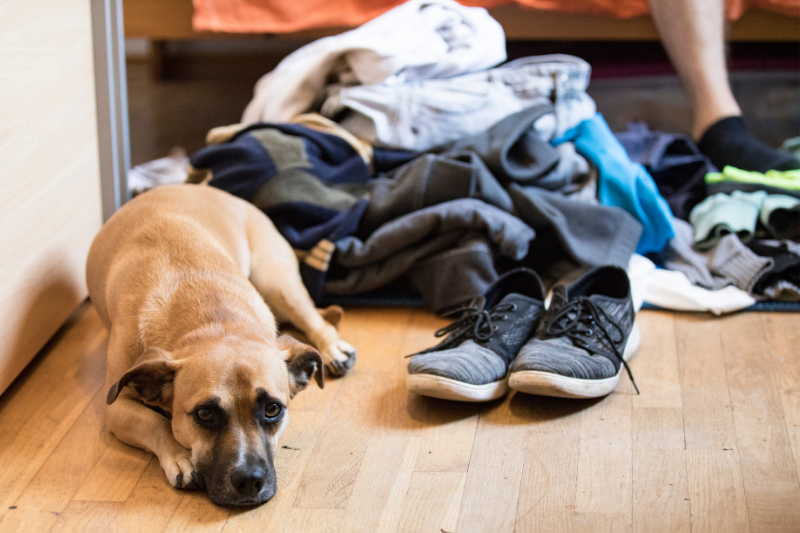The 4 Steps to New Habits with ADHD: Taking control of your routines to better meet your goals
 Do you have a habit of saving old boxes in case you might need them at some point in the future? Or, perhaps you let your mail accumulate in a pile because you dread the sorting process or slam doors when you are angry? Some habits, like walking with the dog in the morning, wiping down counters before going to bed or laying out clothes for the next day, can be useful, and even good for you. Others, however, can hold you back and fuel unwanted clutter, chaos or unhealthy lifestyles. But, as the saying goes, old habits die hard. As much as you may want to change what you know doesn’t serve you, it can seem impossible–especially for adults with ADHD–to plan, initiate and follow through with making a much-needed shift. By focusing on one specific goal at a time, here’s how you can create new habits with ADHD.
Do you have a habit of saving old boxes in case you might need them at some point in the future? Or, perhaps you let your mail accumulate in a pile because you dread the sorting process or slam doors when you are angry? Some habits, like walking with the dog in the morning, wiping down counters before going to bed or laying out clothes for the next day, can be useful, and even good for you. Others, however, can hold you back and fuel unwanted clutter, chaos or unhealthy lifestyles. But, as the saying goes, old habits die hard. As much as you may want to change what you know doesn’t serve you, it can seem impossible–especially for adults with ADHD–to plan, initiate and follow through with making a much-needed shift. By focusing on one specific goal at a time, here’s how you can create new habits with ADHD.
Habits and ADHD: When they help and when they don’t
 Habits are defined as acquired patterns of behavior that are regularly repeated until they become almost involuntary. Habits usually develop to help us lower stress or meet an emotional need such as reducing fear, sadness or hurt. They may serve us when we start them and then cease to be useful, but we still can’t seem to stop doing them. This is particularly tough for many adults with ADHD who struggle with executive functioning challenges such as organization, impulse control and focus. With a ‘Now/Not Now’ brain, the satisfaction of doing a habit in the moment can overtake rational thoughts of making a different choice or simply tolerating the discomfort of change.
Habits are defined as acquired patterns of behavior that are regularly repeated until they become almost involuntary. Habits usually develop to help us lower stress or meet an emotional need such as reducing fear, sadness or hurt. They may serve us when we start them and then cease to be useful, but we still can’t seem to stop doing them. This is particularly tough for many adults with ADHD who struggle with executive functioning challenges such as organization, impulse control and focus. With a ‘Now/Not Now’ brain, the satisfaction of doing a habit in the moment can overtake rational thoughts of making a different choice or simply tolerating the discomfort of change.
The three elements of a habit
Habits consist of loops of three elements: the trigger, the behavior and the benefit.
1. The trigger:
Initially, there is a trigger. For example, perhaps you are feeling anxious about a work issue. Then you see an email from your boss after dinner that intensifies your worry, and you are now feeling uncomfortable.
2. The behavior:
What happens next is the routine. A behavior or a set of actions that is geared towards distracting you or making you feel better. You plop down on your sofa and proceed to watch four hours of television.
3. The benefit:
The resulting reward is that you are sufficiently engrossed in your entertainment and not thinking about your boss (the trigger), so the habit is now complete. However, there’s a downside to this habit: you stay up too late, struggle to wake up the next morning, and get to work late again.
How to prepare for new habits with ADHD
Changing a habit means targeting one of the three habit components: reacting differently to the trigger, choosing an alternative behavior to address the ensuing discomfort, or responding to the pull of the benefit/reward with a healthier option.  In order to begin the process of changing a habit, you have to bring awareness to what it is and when you are engaging it. This is where mindfulness meets metacognition: you notice the habit, you observe the effect that it has on you (and others) and you reflect on what other options exist that would feel rewarding. Practice self-awareness in combination with self-evaluation: try to reflect on whatever beliefs you have about yourself or your life that are tied to the old habit – and without any judgment. Old habits are tough to break because they are familiar and easy to do. They can also promote safety from uncomfortable feelings, insecurity, irrational fears and/or self-criticism. Rather than letting shame or regret bring you down, practice self-compassion so you can move forward.
In order to begin the process of changing a habit, you have to bring awareness to what it is and when you are engaging it. This is where mindfulness meets metacognition: you notice the habit, you observe the effect that it has on you (and others) and you reflect on what other options exist that would feel rewarding. Practice self-awareness in combination with self-evaluation: try to reflect on whatever beliefs you have about yourself or your life that are tied to the old habit – and without any judgment. Old habits are tough to break because they are familiar and easy to do. They can also promote safety from uncomfortable feelings, insecurity, irrational fears and/or self-criticism. Rather than letting shame or regret bring you down, practice self-compassion so you can move forward.
The 4 steps to creating new, effective habits
Step 1: Notice a habit
 Noticing a habit without judgment is key towards changing it. Look around your life, and select one thing that you would like to change. Instead of telling yourself negative things about the habit, remember that it once served a purpose and now it doesn’t. That’s all. Then, look at how the habit is affecting you now. If you could wave a magic wand and change it, what would you do? What would you like to see replace it? This is your overarching goal.
Noticing a habit without judgment is key towards changing it. Look around your life, and select one thing that you would like to change. Instead of telling yourself negative things about the habit, remember that it once served a purpose and now it doesn’t. That’s all. Then, look at how the habit is affecting you now. If you could wave a magic wand and change it, what would you do? What would you like to see replace it? This is your overarching goal.
Step 2: Be specific about your goals
Precision is what’s needed to alter habits. It’s not enough to say, “I want to be on time to things,” because it’s not specific enough. Ask yourself questions about your goal that can help you hone in on the details. For example:
-
- What is one area of your life where being on time really matters and would make a difference?
- How will you arrive at the destination?
- How early do you want to arrive?
When you clarify what you want, it’s easier to make it happen.
Step 3: Break the goal down
Reduce your overarching goals into smaller parts that are manageable and achievable. Changing the whole aspect of an unwanted habit might be overwhelming and too difficult. Think in increments instead.
-
- What is one part that you could start with?
- Can you do this daily or weekly?
- What type of support would assist you from a friend, loved one or colleague?
Write down your larger goal, its smaller components and your strategy to refer to it.
Step 4: Practice, and aim for improvement–not perfection
 Practice makes progress. All too often, people who are trying to change a habit dismiss their efforts along the way and only value the completion of the goal. You will need to encourage yourself to keep going and kindly talk back to the part of you that is connected to the old habit. It’s struggling to let go until it can be very sure that the new replacement habit will address any underlying fear, sadness or deficiency beliefs. Embrace the challenge of sustained practice instead of aiming for perfection. And remember, mistakes foster growth. It’s natural and expected to stumble, regroup and try again.
Practice makes progress. All too often, people who are trying to change a habit dismiss their efforts along the way and only value the completion of the goal. You will need to encourage yourself to keep going and kindly talk back to the part of you that is connected to the old habit. It’s struggling to let go until it can be very sure that the new replacement habit will address any underlying fear, sadness or deficiency beliefs. Embrace the challenge of sustained practice instead of aiming for perfection. And remember, mistakes foster growth. It’s natural and expected to stumble, regroup and try again.
Read more blog posts:
- ADHD and Self-Sabotage: 6 supportive strategies to help you feel more confident and reach more goals
- Creating an ADHD-Friendly Morning Routine with Your Family: Wake up to a smoother start
- New Year, New Habits, Same ADHD: How to plan for and maintain new habits together, as a family
Watch on Dr. Saline’s YouTube Channel:
Handouts, Videos & More in Dr. Saline’s Store: https://drsharonsaline.com/product/harness-grit/ https://drsharonsaline.com/product/home-seminar/
